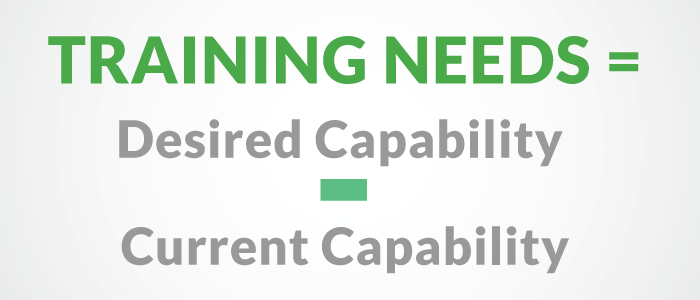When it comes to corporate training, one of the biggest mistakes that companies often make is that they start putting together training plans based on perceived training needs.
The result: Training programs are not based on a proper needs assessment, and therefore these are highly ineffective.
In this article, we’ll take a look at the importance of evaluating corporate training needs; and then we’ll offer some best practices on how to conduct such an assessment.
Signs of a Need
Every performance gap is not necessarily a training opportunity.
For instance, an actual shortfall in the quarterly sales revenue forecast should not immediately be ascribed to a training deficit.
There may be various non-training reasons for it:
- The product/service is not what the market wants
- The company is facing extraordinarily stiff competition
- Pricing isn’t too attractive to close the deal
- Bad weather or recession is hurting the overall industry – not just the company
Therefore, the first thing that one should do to assess training needs is to evaluate the underlying signs of such a need:
- Complaints on the rise about Salespeople not pricing a a product/service correctly
- A spike in shop floor accidents related to the new assembly plant
- Technicians always making inquiries about “What to do if a client asks…” from their supervisors
Situations such as these are likely indicators that there is a training gap that must be addressed.
Read more: When to Invest in Training Your Employees
However, the big questions are:
How do you train?
Who do you focus your training on?
What training should be delivered?
You just can’t issue a policy edict on training and expect the underlying issues to be fixed.
That is why you need to conduct a training needs assessment before making any further training decisions!

The Genesis of a Training Needs Analysis
The Training Needs Assessment is a 3-tiered process, which must be conducted in the following sequence:
Step 1: Organizational assessment- Assess organization and its goals and objectives.
The first step is to ensure that any training initiatives that come out of the needs assessment are in sync with the organization’s goals and vision.
Here some things to consider:
- Is this a departmental or organization-wide need?
- Are there training (or operational) resources elsewhere in the company that can be leveraged?
- Will the resulting training converge or diverge with company aims objectives?
- Are there company-wide training impediments that must be removed first?
- Is management prepared to support the findings of any needs assessment?
- Is there a willingness to fund any training initiatives identified?
The aim is to get senior company executives on the same page so that there is the highest level of acknowledgment of the need for training, and visible endorsement for training initiatives. This assessment will also shed valuable light on standardizing training content across the company.
Also read: DON'T Skip the Training Needs Analysis! Here's Why
Step 2: Job-task analysis – Jobs and related tasks that need to be learned.
Whether the issue is localized (say at a departmental, section or divisional level), or organization-wide, the next step is to put each of the tasks (at the center of training need) under the microscope.
Start with these questions:
- Who does this task?
- How often is it done?
- How should this task be done correctly?
- What skills and capabilities are needed to do the job?
- What tools, technologies or resources are used/needed to perform it?
- Are there industry (or global) standards and metrics to evaluate successful outcomes of the task?
The result from this analysis should be a step-by-step listing of what the task involves; as well as timelines and measurements related to doing it right, benchmarks (current time and measurements) for subsequent post-training evaluation, and whether there are any gaps between existing skills and those required for improved performance.
Where jobs are more knowledge-based (compared to activity-based), a cognitive task analysis may be needed. Training content may also need to include sources of additional information (that employees can access) related to this particular task/job.
Step 3: Individual assessment – Who are to be trained?
Research at Cornell University suggests that employees who perform poorly are often clueless of their performance. Performance gaps may not always be across-the-board, necessitating training for every employee in the organization. Performance gap analysis will help you identify where (which departments, sections, branches) such differences exist; or perhaps even who the individuals with performance challenges are.
Things to consider:
- How prevalent are these performance challenges?
- What is the profile of workers with such challenges?
- Do the employees with these issues have the underlying skills and capabilities (discovered in Job-task analysis)?
- How do these individuals like to learn?
- Are the performance challenges really attributable to this person, or are there other factors (poor work-space configuration; lack of leadership; up or down-stream issues) that could explain the performance gaps?
A lot of the inputs to this type of analysis may come from employee annual Performance Analysis that most organizations already conduct. This analysis will not only provide you with a strong set of indications about what content to include in your training but will also give you pointers on how to personalize your training.
Needs Analysis Tools and Techniques
Training needs analysis cannot just be done through the review of corporate documentation or employee training records. Some techniques to use include:
- In-person interviews: Meeting with executives, managers, HR specialists and rank-and-file employees, and talking to them about the challenges and training needs
- Surveys: Designing focused questionnaires and surveys to get inputs from various stakeholders about training needs. Use a good sample survey as a starting point, and then customize it for your needs.
- SME Consultation: Consult with Subject Matter Experts (SMEs) and seek their inputs on training needs and industry and global best practices.
- Focus groups: Strike up a task force that’s mandated to review training needs and provide recommendations on how to go about addressing them.
- On-the-job observations: Have a select group of individuals go into the workplace and directly observe employees performing their jobs. Then, make notes/recommendations about performance gaps and training needs
It may also be a good idea to use all of the points above to prepare a personalized corporate training needs analysis check list, and then use that to guide your decisions about future training.
Before you decide on putting a training program together, you should review all of the feedback received (through the various analysis steps and techniques discussed); and come up with specific training action plans. Preferably, add timelines, manpower estimates and budgetary resources required for each step in the plan.
A good place to start would be to conduct an inventory of existing training assets, skills, and capabilities, and decide how they might be leveraged to fulfill some/all of the needs identified.
Sources:
Training Needs Assessment by Seta Wicaksana, owner www.humanikaconsulting.com


